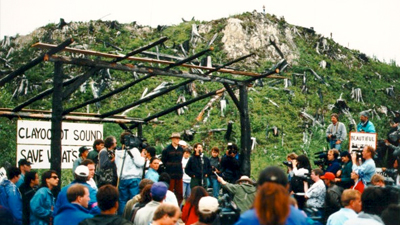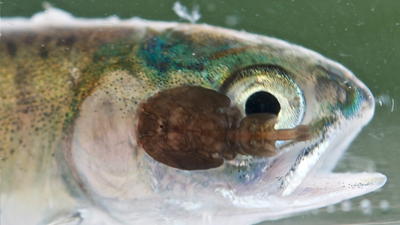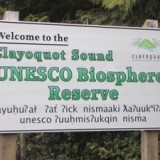“Every normal man must be tempted, at times, to spit upon his hands, hoist the black flag, and begin slitting throats”. (H.L. Mencken)
Those who fought to save the trees at Clayoquot and the tens of thousands of their fellow citizens – indeed environmental defenders from all over the globe – would, if they knew the truth, be appalled and ashamed and fighting mad at what has happened since 1994 when then Premier Mike Harcourt thought he had protected much of the Clayoquot old growth timber.
The battle known as the “War In The Woods” solved little if anything when all’s said and done. In 1993, the war commenced with almost 1000 protesters winding up in jail. The “war” became international with eco-stars like Robert F. Kennedy getting in the trenches. Clayoquot Sound was named a Biosphere Reserve by UNESCO. An independent panel of scientists got into the act as did the NDP government of the day – but once the fine print was read, the various agreements and legislative efforts following 1993 did little to change things. Tragically, as too often is the case, destitute First Nations – aided by newer, smaller outside companies only too eager to help them harvest and sell Clayoquot’s forests – wound up doing the logging. And they were no better able to do it in an environmentally sound way than were the large companies which left because they couldn’t make money if the new rules were enforced. The bottom line is that whether the area was clear-cut, helicopter logged, or a combination of methods, they could no longer turn a profit, so they left. But the First Nations need money and the forest suffers accordingly.

In the final analysis, Clayoquot Sound is an international symbol of how environmental fights usually end with the environmental groups winning the battle yet losing the war.
In fact, Clayoquot Sound environmentalists resemble a prize fighter who valiantly gets off the canvass only to be knocked down again, for in addition to the forestry battle they thought they had won, they might now be down for the count with several other environmental catastrophes in the ring wielding knockout punches.
Clayoquot Sound is an unbelievable gem in a coast of gems. Famous for its waves which attract thousands of surfers every year, it is, or was, also famous for its salmon fishing. Perhaps most of all, Clayoquot Sound is a place you want to be – a spectacular rain forest close enough to “civilization” to be reachable, yet seemingly remote.
As if the logging weren’t bad enough, there is a proposed copper mine on Catface Mountain, which, if it is approved and brought to fruition, will literally lop off a third of the mountain – and mine deep into its core. The good news is that the test drilling thus far shows low grade copper, calling into doubt its viability; the bad news is that if world prices of copper are high, this means huge open pit mining because extracting low grade mineral means much more rock must be taken for the undertaking to work. As I write this, 22 further holes are being drilled and results will be known by year’s end.

Clayoquot Sound has always been known for spectacular fishing, supporting substantial commercial and sports fisheries. Enter the salmon farmers. Much attention has been paid to the ruinous contact of Broughton Archipelago migrating salmon and the clouds of sea lice from fish farms there. More recently, thanks to the vigorous scientific work by Alexandra Morton, the environmentalist hero of the Broughton tragedy, we now know that sockeye from the Fraser are all but certainly facing the same fish farm-induced perils faced by the pinks and chum in the Broughton Archipelago. While the research into the impacts of salmon farms continues at Clayoquot Sound, every indication is that it’s Broughton Archipelago re-visited, and then some. (See my colleague Damien Gillis’ new film on the salmon farm situation in Clayoquot here).
The Department of Fisheries and Oceans is on the matter, but how comforting is that? Will it be the same DFO we’ve come to have contempt for? Will it again be like lying sick in hospital and the undertaker comes to visit with a tape measure in his hand? Unhappily, that’s not all. Tofino dumps its raw sewage into the ocean, sewage that increases as tourists arrive. The mayor and council know the harm this does but say, simply, that with the tax base they must work with they simply cannot provide the treatment that’s needed.

The mayor and council have done their damndest to protect their beautiful unique sound, as have environmental groups, but as long as the situation I’ve described continues, it will be one pace forward, two paces back.
History tells us that DFO, who is supposed to protect wild fish, is mandated to support fish farms by a government of ignorant cretins which hasn’t a soupçon of care for the environment. We also know that the provincial government can’t wait to have private companies destroy our rivers for power and the profits destined for out-of-province shareholders of large international corporations – indeed one private power dam (the industry prefers we call them weirs) is under construction in Clayoquot, with several more to follow.
Clayoquot Sound, the place everyone thought had been made safe for nature, sits on the edge of the precipice overlooking utter destruction while industry – and it must be said some First Nations – and the two senior governments are fighting to see who will give it the last and fatal push.
If we are to have any hope of truly protecting this magical place, it’s high time we hoisted up that black flag again.

